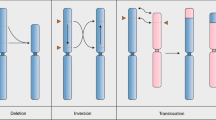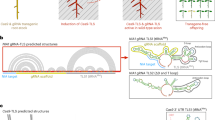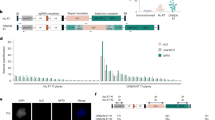Abstract
The development of technologies for the stable genetic transformation of plastid (chloroplast) genomes has been a boon to both basic and applied research. However, extension of the transplastomic technology to major crops and model plants has proven extremely challenging, and the species range of plastid transformation is still very much limited in that most species currently remain recalcitrant to plastid genome engineering. Here, we report an efficient plastid transformation technology for the model plant Arabidopsis thaliana that relies on root-derived microcalli as a source tissue for biolistic transformation. The method produces fertile transplastomic plants at high frequency when combined with a clustered regularly interspaced short palindromic repeats (CRISPR)–CRISPR-associated protein 9 (Cas9)-generated knockout allele of a nuclear locus that enhances sensitivity to the selection agent used for isolation of transplastomic events. Our work makes the model organism of plant biology amenable to routine engineering of the plastid genome, facilitates the combination of plastid engineering with the power of Arabidopsis nuclear genetics, and informs the future development of plastid transformation protocols for other recalcitrant species.
This is a preview of subscription content, access via your institution
Access options
Access Nature and 54 other Nature Portfolio journals
Get Nature+, our best-value online-access subscription
$29.99 / 30 days
cancel any time
Subscribe to this journal
Receive 12 digital issues and online access to articles
$119.00 per year
only $9.92 per issue
Buy this article
- Purchase on Springer Link
- Instant access to full article PDF
Prices may be subject to local taxes which are calculated during checkout





Similar content being viewed by others
Data availability
The data supporting the findings of this study are available within the paper and its Supplementary Information files. Annotated sequences of plastid transformation vectors pCH8, pJF1151 and pJF1153 have been deposited in GenBank (accession numbers MH590891, MH590893 and MH590894). Nature Plants thanks Francis Quétier, Spencer M. Whitney and other anonymous reviewers for their contributions to the peer review of this work.
References
Boynton, J. E. et al. Chloroplast transformation in Chlamydomonas with high velocity microprojectiles. Science 240, 1534–1538 (1988).
Svab, Z., Hajdukiewicz, P. & Maliga, P. Stable transformation of plastids in higher plants. Proc. Natl Acad. Sci. USA 87, 8526–8530 (1990).
Maliga, P. Plastid transformation in higher plants. Annu. Rev. Plant. Biol. 55, 289–313 (2004).
Maliga, P. & Bock, R. Plastid biotechnology: food, fuel, and medicine for the 21st century. Plant Physiol. 155, 1501–1510 (2011).
Bock, R. Engineering plastid genomes: methods, tools, and applications in basic research and biotechnology. Annu. Rev. Plant Biol. 66, 211–241 (2015).
Fuentes, P., Armarego-Marriott, T. & Bock, R. Plastid transformation and its application in metabolic engineering. Curr. Opin. Biotechnol. 49, 10–15 (2018).
Takahashi, Y., Goldschmidt-Clermont, M., Soen, S.-Y., Franzen, L. G. & Rochaix, J.-D. Direct chloroplast transformation in Chlamydomonas reinhardtii: insertional inactivation of the psaC gene encoding the iron sulfur protein destabilizes photosystem I. EMBO J. 10, 2033–2040 (1991).
Hager, M., Biehler, K., Illerhaus, J., Ruf, S. & Bock, R. Targeted inactivation of the smallest plastid genome-encoded open reading frame reveals a novel and essential subunit of the cytochrome b 6 f complex. EMBO J. 18, 5834–5842 (1999).
Huang, C. Y., Ayliffe, M. A. & Timmis, J. N. Direct measurement of the transfer rate of chloroplast DNA into the nucleus. Nature 422, 72–76 (2003).
Stegemann, S. & Bock, R. Exchange of genetic material between cells in plant tissue grafts. Science 324, 649–651 (2009).
Bock, R. Witnessing genome evolution: experimental reconstruction of endosymbiotic and horizontal gene transfer. Annu. Rev. Genet. 51, 1–22 (2017).
Lu, Y., Rijzaani, H., Karcher, D., Ruf, S. & Bock, R. Efficient metabolic pathway engineering in transgenic tobacco and tomato plastids with synthetic multigene operons. Proc. Natl Acad. Sci. USA 110, E623–E632 (2013).
Tregoning, J. S. et al. Expression of tetanus toxin fragment C in tobacco chloroplasts. Nucleic Acids Res. 31, 1174–1179 (2003).
Bock, R. & Warzecha, H. Solar-powered factories for new vaccines and antibiotics. Trends Biotechnol. 28, 246–252 (2010).
McBride, K. E. et al. Amplification of a chimeric Bacillus gene in chloroplasts leads to an extraordinary level of an insecticidal protein in tobacco. Biotechnology 13, 362–365 (1995).
Zhang, J. et al. Full crop protection from an insect pest by expression of long double-stranded RNAs in plastids. Science 347, 991–994 (2015).
Bock, R. Genetic engineering of the chloroplast: novel tools and new applications. Curr. Opin. Biotechnol. 26, 7–13 (2014).
Ruf, S., Hermann, M., Berger, I. J., Carrer, H. & Bock, R. Stable genetic transformation of tomato plastids and expression of a foreign protein in fruit. Nat. Biotechnol. 19, 870–875 (2001).
Sidorov, V. A. et al. Stable chloroplast transformation in potato: use of green fluorescent protein as a plastid marker. Plant J. 19, 209–216 (1999).
Kanamoto, H. et al. Efficient and stable transformation of Lactuca sativa L. cv. Cisco (lettuce) plastids. Transgenic Res. 15, 205–217 (2006).
Okumura, S. et al. Transformation of poplar (Populus alba) plastids and expression of foreign proteins in tree chloroplasts. Transgenic Res. 15, 637–646 (2006).
Sikdar, S. R., Serino, G., Chaudhuri, S. & Maliga, P. Plastid transformation in Arabidopsis thaliana. Plant Cell Rep. 18, 20–24 (1998).
Yu, Q., Lutz, K. A. & Maliga, P. Efficient plastid transformation in Arabidopsis. Plant Physiol. 175, 186–193 (2017).
Hibberd, J. M. A major advance in plastid transformation. Plant Physiol. 175, 5 (2017).
Preuten, T. et al. Fewer genes than organelles: extremely low and variable gene copy numbers in mitochondria of somatic plant cells. Plant J. 64, 948–959 (2010).
Parker, N., Wang, Y. & Meinke, D. Natural variation in sensitivity to a loss of chloroplast translation in Arabidopsis. Plant Physiol. 166, 2013–2027 (2014).
Parker, N., Wang, Y. & Meinke, D. Analysis of Arabidopsis accessions hypersensitive to a loss of chloroplast translation. Plant Physiol. 172, 1862–1875 (2016).
Scharff, L. B. & Bock, R. Synthetic biology in plastids. Plant J. 78, 783–798 (2014).
Ikeuchi, M., Ogawa, Y., Iwase, A. & Sugimoto, K. Plant regeneration: cellular origins and molecular mechanisms. Development 143, 1442–1451 (2016).
Weigel, D. & Glazebrook, J. Root transformation of Arabidopsis. Cold Spring Harb. Protoc. https://doi.org/10.1101/pdb.prot4671 (2006).
Bechtold, U., Ferguson, J. N. & Mullineaux, P. M. To defend or to grow: lessons from Arabidopsis C24. J. Exp. Bot. 69, 2809–2821 (2018).
Fujimoto, R., Taylor, J. M., Shirasawa, S., Peacock, W. J. & Dennis, E. S. Heterosis of Arabidopsis hybrids between C24 and Col is associated with increased photosynthesis capacity. Proc. Natl Acad. Sci. USA 109, 7109–7114 (2012).
Svab, Z. & Maliga, P. High-frequency plastid transformation in tobacco by selection for a chimeric aadA gene. Proc. Natl Acad. Sci. USA 90, 913–917 (1993).
Zubko, M. K. & Day, A. Stable albinism induced without mutagenesis: a model for ribosome-free plastid inheritance. Plant J. 15, 265–271 (1998).
Huang, F.-C. et al. Efficient plastid transformation in tobacco using the aphA-6 gene and kanamycin selection. Mol. Genet. Genomics 268, 19–27 (2002).
Kahlau, S. & Bock, R. Plastid transcriptomics and translatomics of tomato fruit development and chloroplast-to-chromoplast differentiation: chromoplast gene expression largely serves the production of a single protein. Plant Cell 20, 856–874 (2008).
Valkov, V. T. et al. Genome-wide analysis of plastid gene expression in potato leaf chloroplasts and tuber amyloplasts: transcriptional and posttranscriptional control. Plant Physiol. 150, 2030–2044 (2009).
Caroca, R., Howell, K. A., Hasse, C., Ruf, S. & Bock, R. Design of chimeric expression elements that confer high-level gene activity in chromoplasts. Plant J. 73, 368–379 (2013).
Zhang, J. et al. Identification of cis-elements conferring high levels of gene expression in non-green plastids. Plant J. 72, 115–128 (2012).
Kuroda, H. & Maliga, P. Complementarity of the 16S rRNA penultimate stem with sequences downstream of the AUG destabilizes the plastid mRNAs. Nucleic Acids Res. 29, 970–975 (2001).
Ye, G.-N. et al. Plastid-expressed 5-enolpyruvylshikimate-3-phosphate synthase genes provide high level glyphosate tolerance in tobacco. Plant J. 25, 261–270 (2001).
Tangphatsornruang, S., Birch-Machin, I., Newell, C. A. & Gray, J. C. The effect of different 3′ untranslated regions on the accumulation and stability of transcripts of a gfp transgene in chloroplasts of transplastomic tobacco. Plant Mol. Biol. 76, 385–396 (2011).
Wang, Z.-P. et al. Egg cell-specific promoter-controlled CRISPR/Cas9 efficiently generates homozygous mutants for multiple target genes in Arabidopsis in a single generation. Genome Biol. 16, 144 (2015).
Azhagiri, A. K. & Maliga, P. Exceptional paternal inheritance of plastids in Arabidopsis suggests that low-frequency leakage of plastids via pollen may be universal in plants. Plant J. 52, 817–823 (2007).
Ruf, S., Karcher, D. & Bock, R. Determining the transgene containment level provided by chloroplast transformation. Proc. Natl Acad. Sci. USA 104, 6998–7002 (2007).
Greiner, S., Sobanski, J. & Bock, R. Why are most organelle genomes transmitted maternally? Bioessays 37, 80–94 (2014).
Ort, D. R. et al. Redesigning photosynthesis to sustainably meet global food and bioenergy demand. Proc. Natl Acad. Sci. USA 112, 8529–8536 (2015).
Sharwood, R. E. Engineering chloroplasts to improve Rubisco catalysis: prospects for translating improvements into food and fiber crops. New Phytol. 213, 494–510 (2017).
Naqvi, S. et al. Transgenic multivitamin corn through biofortification of endosperm with three vitamins representing three distinct metabolic pathways. Proc. Natl Acad. Sci. USA 106, 7762–7767 (2009).
Fuentes, P. et al. A new synthetic biology approach allows transfer of an entire metabolic pathway from a medicinal plant to a biomass crop. eLife 5, e13664 (2016).
Staub, J. M. & Maliga, P. Translation of the psbA mRNA is regulated by light via the 5′-untranslated region in tobacco plastids. Plant J. 6, 547–553 (1994).
Barahimipour, R. et al. Dissecting the contributions of GC content and codon usage to gene expression in the model alga Chlamydomonas reinhardtii. Plant J. 84, 704–717 (2015).
Ehrnthaler, M. et al. Synthetic lethality in the tobacco plastid ribosome and its rescue at elevated growth temperatures. Plant Cell 26, 765–776 (2014).
Murashige, T. & Skoog, F. A revised medium for rapid growth and bio assays with tobacco tissue culture. Physiol. Plant. 15, 473–497 (1962).
Matsubayashi, Y., Goto, T. & Sakagami, Y. Chemical nursing: phytosulfokine improves genetic transformation efficiency by promoting the proliferation of surviving cells on selective media. Plant Cell Rep. 23, 155–158 (2004).
Hellens, R. P., Edwards, E. A., Leyland, N. R., Bean, S. & Mullineaux, P. M. pGreen: a versatile and flexible binary Ti vector for Agrobacterium-mediated plant transformation. Plant Mol. Biol. 42, 819–832 (2000).
Doyle, J. J. & Doyle, J. L. Isolation of plant DNA from fresh tissue. Focus 12, 13–15 (1990).
Acknowledgements
We thank M. M. Bednarska, C. Runge and M. Rößner for excellent technical assistance, K. Kiemel and R. Narawitz for media preparation and help with tissue culture, D. Kleinschmidt for microscopy, and J. Zhang and D. Karcher for help with vector design. This research was financed by the Max Planck Society and a grant from the European Research Council under the European Union’s Horizon 2020 research and innovation programme (ERC-ADG-2014; grant agreement 669982) to R.B.
Author information
Authors and Affiliations
Contributions
S.R., J.F. and R.B. designed the research. C.H., X.K., S.S., A.S., L.S. and J.F. performed the experiments. All authors participated in data evaluation. R.B. wrote the manuscript, with input from S.R. and J.F.
Corresponding author
Ethics declarations
Competing interests
The authors declare no competing interests.
Additional information
Journal peer review information: Nature Plants thanks Francis Quétier, Spencer M. Whitney and other anonymous reviewers for their contributions to the peer review of this work.
Publisher’s note: Springer Nature remains neutral with regard to jurisdictional claims in published maps and institutional affiliations.
Supplementary information
Supplementary Information
Supplementary Figures 1–8 and Supplementary Table 1.
Rights and permissions
About this article
Cite this article
Ruf, S., Forner, J., Hasse, C. et al. High-efficiency generation of fertile transplastomic Arabidopsis plants. Nat. Plants 5, 282–289 (2019). https://doi.org/10.1038/s41477-019-0359-2
Received:
Accepted:
Published:
Issue Date:
DOI: https://doi.org/10.1038/s41477-019-0359-2
This article is cited by
-
TALE-based organellar genome editing and gene expression in plants
Plant Cell Reports (2024)
-
Control of plastid inheritance by environmental and genetic factors
Nature Plants (2023)
-
Optimized synthesis of layered double hydroxide lactate nanosheets and their biological effects on Arabidopsis seedlings
Plant Methods (2022)
-
Engineering the plastid and mitochondrial genomes of flowering plants
Nature Plants (2022)
-
De-etiolation-induced protein 1 (DEIP1) mediates assembly of the cytochrome b6f complex in Arabidopsis
Nature Communications (2022)



